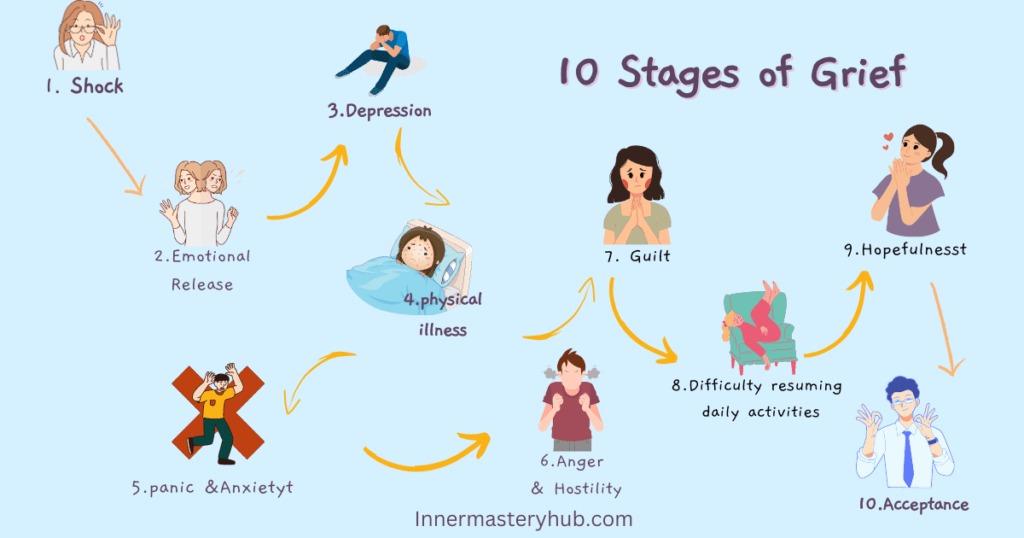Tension in the Neck and Shoulders From Anxiety

Finding stiffness or tension in the neck and shoulders might make you feel as though you’re carrying an extra burden that is affecting your physical and emotional health. Every motion is awkward when you’re with an unwelcome spouse. So what’s making this difficult?
Tension carrying, poor posture, and even extended periods of inactivity may be the culprit. But don’t worry, we’ll explain the causes of neck and shoulder muscle tension in great depth in this blog post, provide some practical relaxation techniques, and help you live pain-free.
Our goal is to empower you to understand your body better and guide you on your journey to health and well-being. Let’s get started, then.
Can Stress Cause Shoulder Pain?
Shoulder and neck pain can be exacerbated by carrying tension. The fight-or-flight response in our physiology causes our muscles to stiffen in stressful situations. In the shoulders and neck, this muscle tightness is frequently the most obvious indication.
According to a study that was published in the Journal of Physical Therapy Science, psychological stress and shoulder and neck pain are significantly correlated, especially for office workers.
According to the study, prolonged computer use and high levels of felt stress were associated with shoulder and back pain, underscoring the importance of ergonomic workplace interventions and stress management.
Can stress cause tension in the neck and shoulders?
Tension in the shoulder joints and even neck pain can be exacerbated by stress and anxiety. Headaches, neck and back pain, and muscle tightness or spasms, especially in the neck and shoulders, are examples of physical signs of stress,
according to the American Institute of Stress. Anxiety causes stress hormones to be released as the body goes into “fight or flight” Mode. These hormones cause tissues to stiffen in anticipation of potential harm.
Persistent pain might prevent muscles from relaxing, leading to long-term tension. This strain can develop into a chronic condition over time, creating a difficult-to-break cycle of pain and worry.
Why Does Stress Lead to Neck and Shoulder Pain?
One psychological phenomenon that significantly affects our bodies is stress. According to famous physiotherapist Dr. Alice Jones, when our thoughts interpret stressful situations as dangerous, our bodies go into fight-or-flight Mode.
This Survival system releases stress hormones such as cortisol and adrenaline, preparing our bodies to face stressful conditions or escape imagined health problems. Body reactions to stressful events can cause stiff muscles, particularly in the neck and shoulders, elevated blood pressure, and a fast heartbeat.
Let’s look at Jane, a 35-year-old software engineer who has persistent back pain in her left shoulder and cervical region. She tries to maintain an ergonomic setup and take regular breaks, but the ache persists. After speaking with a physiotherapist, she concluded that the main reason was her ongoing work-related stress.
Jane’s story serves as a warning that physical symptoms such as tension headaches, migraines, shoulder discomfort, and neck aches can be brought on by prolonged stress.
Shoulder rolls
Another exercise that may help ease the strain on the shoulders and neck is the shoulder roll. This workout is simple but effective, and it can be done practically anywhere without additional equipment. Near the beginning, sit or stand upright, and bring your shoulders near your ears.
Roll your shoulders slowly in a circular motion, forward and backward, while attempting to pinch your shoulder blades together.
Then, maintain rolling and drop your shoulders for 10 to 15 repetitions. A slow and methodical execution of the actions is crucial. This exercise is a good way to stretch tense neck, shoulder, and cervical muscles. By releasing tension from the shoulders and neck and reminding your body of its natural position, you can improve posture.
Stretches for neck and shoulder pain
Some stretches and exercises might help relieve shoulder and cervical pain. A study published in the International Journal of Physiotherapy and Research, for instance, found that office workers with chronic cervical and shoulder discomfort reported that stretching exercises significantly decreased their pain and increased their range of motion.
Targeting the muscle that runs down the back of the head, through the head and cervix, and into the shoulder, the levator scapulae stretch is frequently advised. To do this stretch:
- Tilt your head to the left side as if trying to touch your ear to your shoulder.
- Use your left hand on the same side to gently pull your head down, deepening the stretch to release tension in the neck and shoulders.
- Repeat on the opposite side.
Let’s examine the instance of Mark, a 45-year-old attorney who frequently experienced back, shoulder, and side pain in addition to pain in his left hand and left shoulder joint from prolonged desk work. Mark’s pain levels considerably reduced after incorporating these physiotherapist-recommended stretches into his daily routine.
He now emphasizes the importance of physical health for maintaining productivity by encouraging all his staff to stretch and take regular breaks.
The Stress Response Leads to Physical Symptoms
There are many different ways that the human body responds to pain, and many of these reactions manifest as physical symptoms. The neurological system that activates the body in “fight or flight” Mode is a relatively common reaction.
This syndrome results in physiological changes, such as slower digestion, stiff muscles, and elevated heart rate and blood pressure, due to the release of stress hormones, including cortisol and adrenaline.
This reaction prepares the body to either face or flee the imagined danger. These reactions, however, can last for a long time when a person is under chronic stress, which can result in physical symptoms including headaches, sleep issues, and shoulder and neck tightness.
Hot or Cold Therapy
Applying hot or cold therapy can significantly help manage stress-induced cervical and shoulder aches [4]. To reduce stiffness and promote healing, hot therapy can enhance circulation and stimulate blood flow to the affected area. Heat wraps, heating pads, or a hot bath can all deliver heat therapy.
By reducing blood flow, cold medication, also known as cryotherapy, lowers inflammation. This is especially helpful in the first few days after a fresh injury. Gel ice packs or cool compresses can be used to apply cold treatment.
It’s important to know when to use each technique, though both hot and cold therapies have advantages and can temporarily ease aches. Use cold for recent injuries or inflammation and heat for persistent pain or stiffness.
Final Thoughts On Carrying Stress And Tension in the Neck And Shoulders
In conclusion, shoulder and neck stress are highly prevalent in sedentary lifestyles, particularly those involving desk work. Due to the physiological stress response, these areas may remain in a state of constant discomfort. However, regular stress-reduction methods and stretching exercises might help lessen these physical effects.
Furthermore, hot or cold therapy may provide immediate relief. It’s critical to remember that managing the root cause of chronic stress is just as crucial as managing its clinical manifestations.
As a result, stress-reduction techniques like mindfulness and belly breathing can be equally helpful. Everybody’s body responds to stress differently, so it’s essential to be aware of yours and give it the care it needs.
Other Ways to Deal with Stress in the Neck and Shoulders
The methods mentioned above are not the only effective strategies to relieve tension and stress in the neck and shoulders. Regular exercise, such as yoga or pilates, helps enhance relaxation and ease stress in neck and shoulder muscles and tissues by increasing strength, flexibility, and balance.
Massage therapy, whether self-administered or professionally performed, eases stiff muscles, improves circulation, and encourages relaxation. You can significantly reduce discomfort in your neck and shoulders caused by improper desk alignment by implementing ergonomic changes to your desk setup.
Symptoms of Shoulder and Neck Stress
The symptoms of shoulder and neck stress can vary depending on the individual and the severity of their stress. Common symptoms generally include:
- A persistent ache in the neck and shoulders.
- Stiffness in the shoulders and neck.
- Difficulty moving the head in specific directions.
A dull ache around the forehead, at the back of the head, and in the neck is a common symptom of tension headaches, which some people may also experience. More bearing stress and strain in the neck and shoulders, as well as strong shooting pains in the cervical region, may indicate a more serious problem, like a pinched nerve.
Muscle spasms, numbness, tingling, and weakness in the hands or arms are additional related symptoms. Pain and discomfort can also make it difficult to fall asleep. If these symptoms worsen or become very uncomfortable, it’s imperative to see a doctor.
Can physical therapy help with stress-related neck and shoulder pain
This explains why manual treatment works so well for relieving stress-related shoulder and neck tightness. To promote better body alignment and lower pressure, a skilled physical therapist can create a customized exercise program to increase flexibility and strengthen tissues.
Avoiding discomfort from repetitive work or desk occupations is made easier with education in body mechanics and ergonomics. TENS and dry needling are two therapies that can help with persistent shoulder and neck pain. Somatic therapy provides both short-term alleviation and long-term solutions for stress-related shoulder and neck pain.
Apply a warm compress.
Stress-induced tension can be relieved by applying a warm compress to the shoulder, neck, and back. Immediate pain relief is provided, tight neck muscles are relaxed, and the warmth improves blood circulation. Soaking a towel in warm water, using a heated gel pack, or using a hot water bottle lets you quickly make a warm compress at home.
Keep the temperature comfortable to avoid burns. Other strategies, such as consistent exercise, mindful breathing, and ergonomic workspace modifications, complement this approach nicely.
Learn How to Manage Stress
Reducing stress, elevating mood, and improving mental health, quality of life, and overall well-being can all be achieved by practicing effective stress management techniques, such as mindfulness and meditation, regular exercise, healthy eating, getting enough sleep, and seeking out social support.
Tips for Relieving Shoulder and Neck Stress
When experiencing shoulder and neck pressure, incorporate relaxation techniques such as belly breathing and meditation into your daily routine. Mindful movements like yoga or tai chi can help alleviate tension. Consider your workspace ergonomics; adjust your chair and computer height to encourage good alignment.
Regular breaks from prolonged sitting or standing can also prevent strain. For immediate relief, try a warm compress to relax muscles. Seek professional help, like body therapy, for persistent discomfort, which provides personalized pain relief and prevention strategies.
Getting Enough Sleep
A healthy sleep schedule is crucial for reducing stress and maintaining overall health. It gives the body more time to recover and renew, which enhances physical vigor, mental clarity, and happiness. Keep a consistent sleep schedule, create a pleasant environment, and consider calming techniques before bed to promote restful sleep.
REFERENCES
[1] Lundberg U, Dohns IE, Melin B, et al. Psychophysiological stress responses, muscle tension, and neck and shoulder pain among supermarket cashiers. Journal of Occupational Health Psychology. 1999;4(3): 245–255. doi:10.1037//1076-8998.4.3.245
[2] https://headachejournal.onlinelibrary.wiley.com/doi/abs/10.1111/head.13215
[3] https://www.ncbi.nlm.nih.gov/pmc/articles/PMC5843960/
[4] https://www.ncbi.nlm.nih.gov/pmc/articles/PMC9281090/
Mayo Clinic. (2021). Office ergonomics: Your how-to guide. https://www.mayoclinic.org/healthy-lifestyle/adult-health/in-depth/office-ergonomics/art-20046169.
Mayo Clinic. (2021). Massage: Explore its many benefits. https://www.mayoclinic.org/healthy-lifestyle/stress-management/in-depth/massage/art-20045743.
FAQs about tension in the neck and shoulders
When should I worry about neck and shoulder tension?
If your neck and shoulder tension lasts more than a few weeks, worsens despite self-care, or is accompanied by numbness, weakness, fever, or neurological signs, see a doctor.
What causes tension in the neck and shoulders?
Tension in the neck and shoulders is often caused by poor posture, prolonged sitting or screen time, stress or anxiety, muscle overuse, sleeping in awkward positions, or repetitive movements.
How does stress cause tension in the neck and shoulders?
When stressed, your body releases hormones that increase muscle contraction. This can cause your neck and shoulder muscles to tighten and remain tense, leading to discomfort or pain.
What are the symptoms of tension in the neck and shoulders?
Symptoms include stiffness, aching or soreness, difficulty turning your head, muscle spasms, headaches, and sometimes tingling or numbness in the shoulders or arms.
Can anxiety make tension in the neck and shoulders worse?
Yes, anxiety can worsen tension in the neck and shoulders by keeping muscles chronically tightened and making pain perception more intense.
Do I need medical treatment for tension in my neck and shoulders?
Often, self-care works, but if neck and shoulder tension doesn’t improve in weeks, or if you have red-flag symptoms (e.g., numbness, weakness, fever), see a healthcare professional for diagnosis and possible therapy. the
Can neck and shoulder tension be from sleeping position?
Absolutely. Sleeping with too high or unsupportive pillows, or in a twisted position, can strain neck muscles, leading to tension in the neck and shoulders.
Is exercise helpful for tension in the neck and shoulders?
Yes — gentle stretching, strengthening, and posture exercises can help reduce tension, improve mobility, and prevent recurrence. Avoid sudden heavy strain.
How can I relieve tension in my neck and shoulders at home?
Use gentle stretching, heat or cold packs, massage, maintain good posture, take breaks from screens, and use relaxation techniques like deep breathing.
Does poor posture lead to tension in the neck and shoulders?
Yes. Poor posture (such as slouching or leaning forward) forces neck muscles to overwork, increasing tension in both neck and shoulders.






